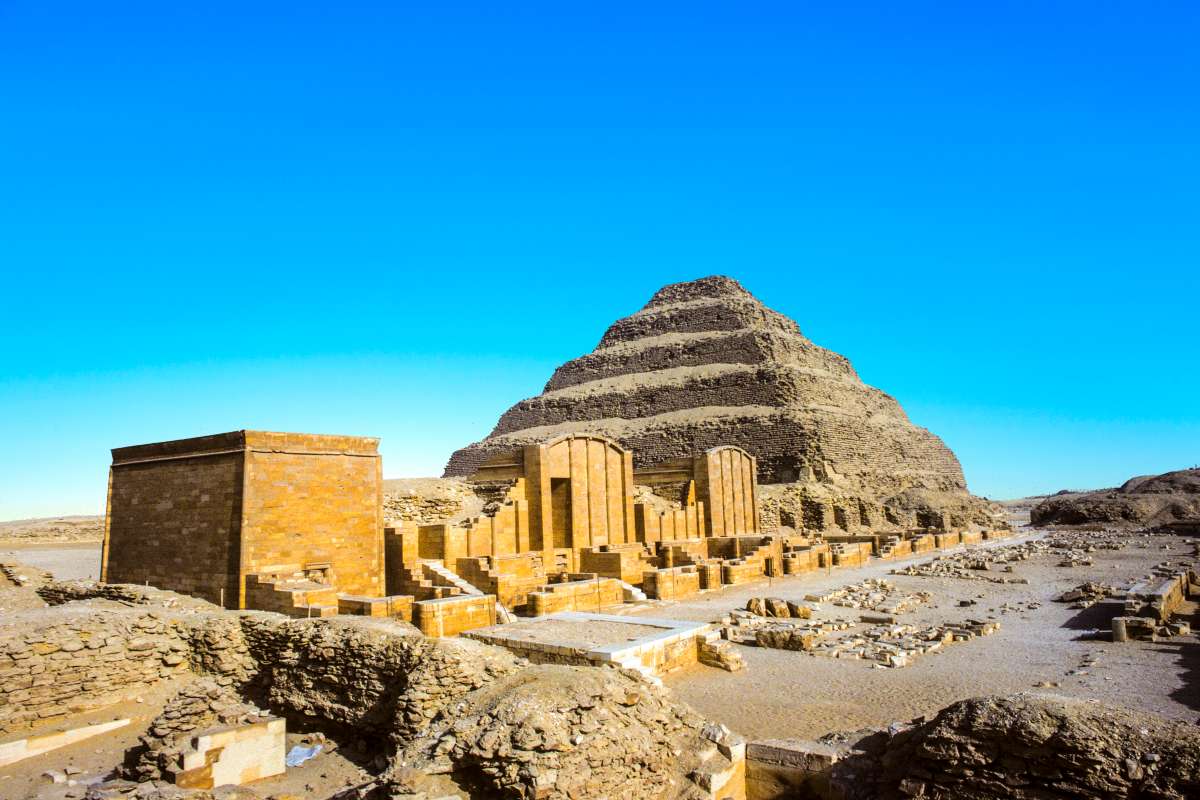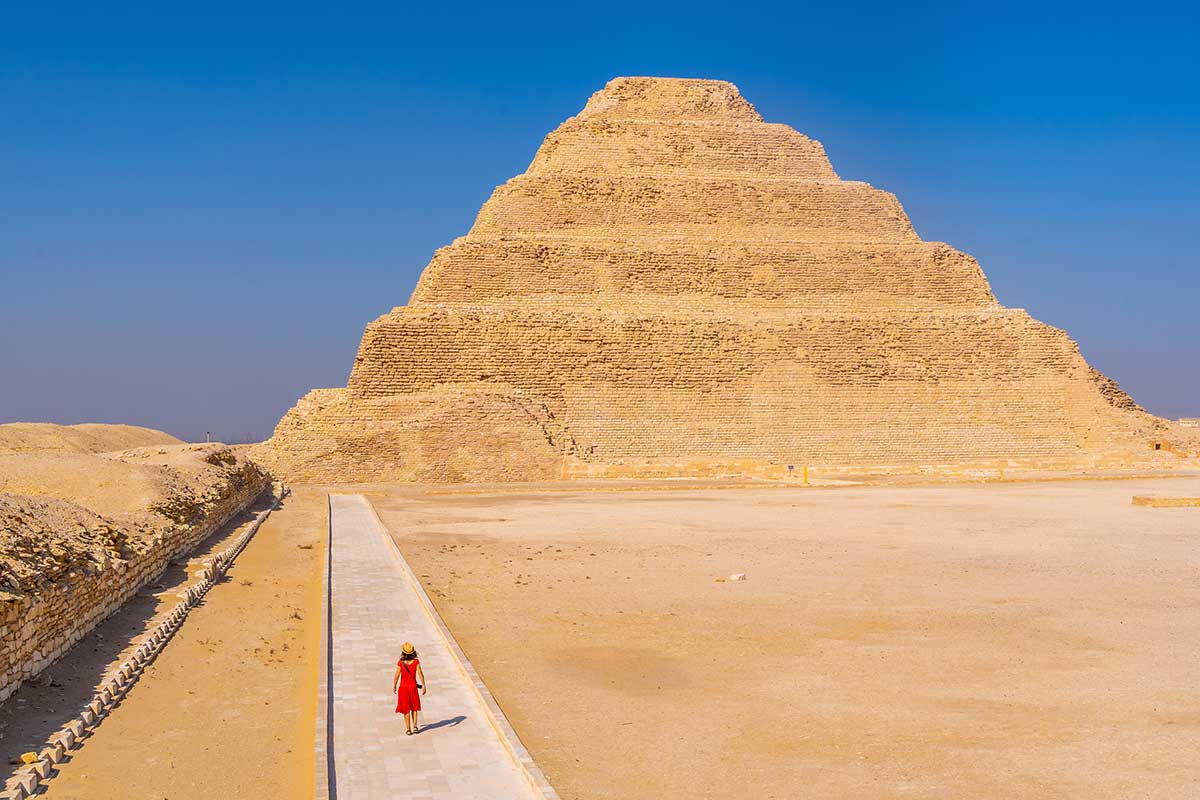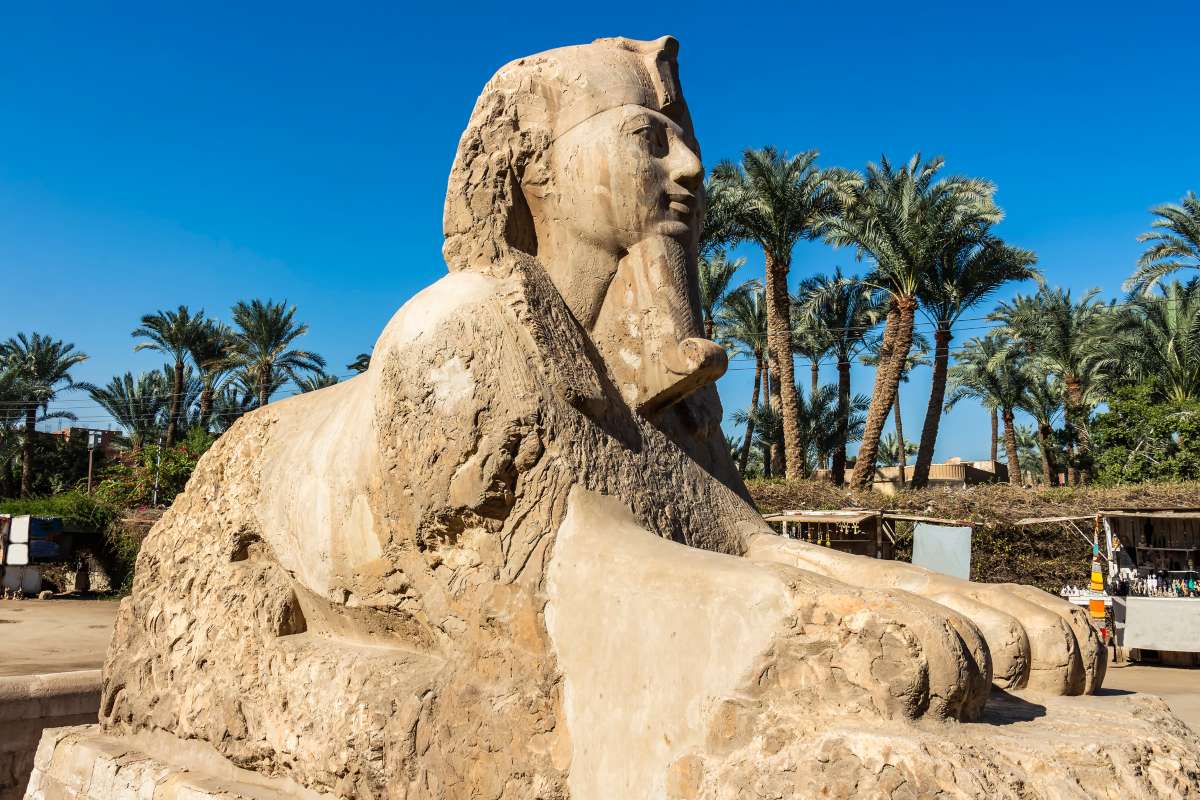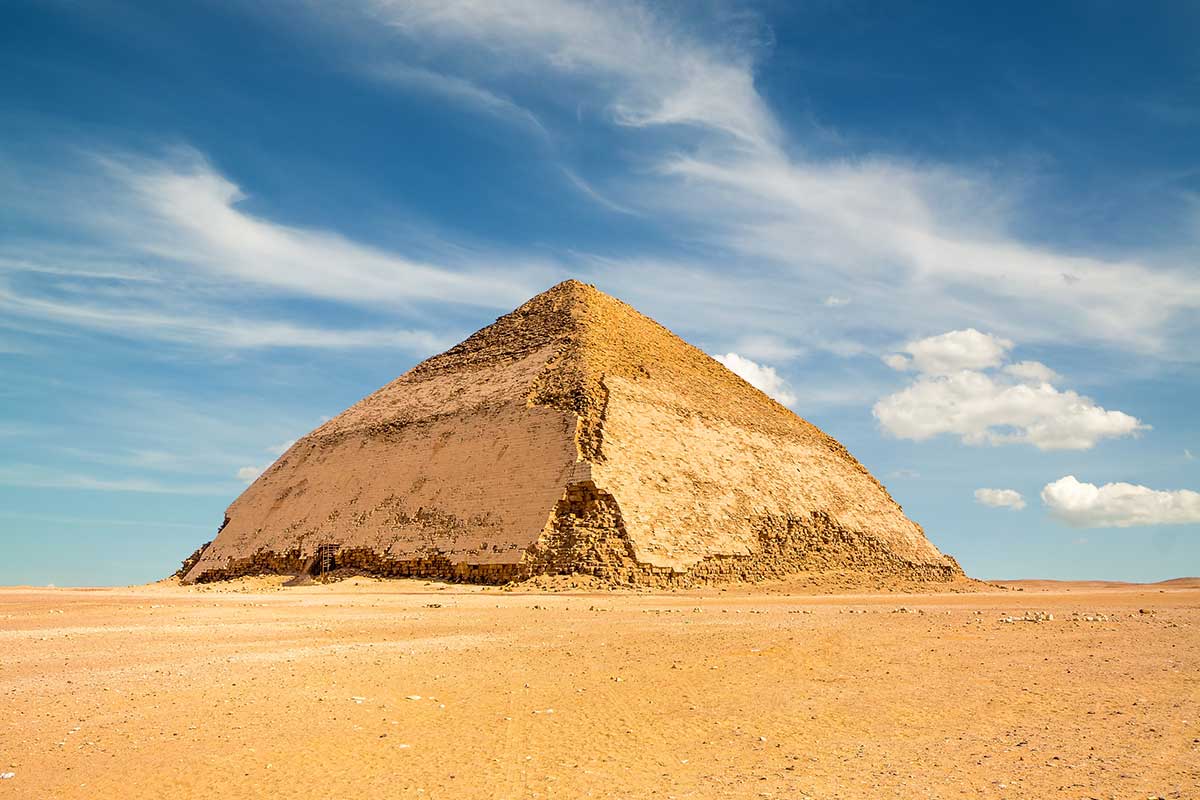Saqqara and Memphis are two places inextricably linked to each other. And not just because of their proximity, but also because of their history. For this reason, it’s common to organize an excursion to Saqqara and Memphis on the same day, usually from Cairo, although it’s also possible to do so from other tourist destinations in Egypt. Their relationship is simple: Memphis was the country’s capital in the times of the Old Kingdom, and Saqqara, one of the necropolises chosen by its pharaohs for eternal rest. It was something similar to what happened, centuries later, with Thebes and the Valley of the Kings, if we admit this parallel.
Additionally, on this page, we add two other places that are also related to Saqqara and Memphis: Abusir and Dahshur. All of them, as well as Giza (to which we dedicate a whole separate page), form a single site declared a World Heritage Site by UNESCO, under the name ‘Memphis and its necropolis. Pyramids areas from Giza to Dahshur’.
So, if you plan to go on an excursion to Saqqara, Memphis, Abusir, or Dahshur, take good note of the information we provide here. And remember that we can organize a tailor-made trip for you, with the duration you wish, the most comfortable transportation service, and the best professionals to accompany you.
Saqqara and Memphis are very close to Cairo… although they already existed several thousand years before the current Egyptian capital was founded. They are about 20 km up the Nile, to the south. You might not find them on a regular map, as the population there now has a different name: Mit Rahina, a small village that sits, literally, on the old Memphis. This is because, after the city was abandoned at the twilight of the ancient Egyptian civilization, the Nile deposited its layers of silt in each flood, and the present-day Mit Rahina was built on them. Therefore, one thing is certain: countless unknown vestiges of that great capital still remain underground, which we may gradually discover in the future thanks to new excavations.
A couple of kilometers closer is Abusir, about 18 km from Cairo, while the farthest necropolis is Dahshur, next to the town of the same name, a little over 30 km away. All these places are on the left bank of the Nile and belong to the Governorate of Giza. On the other side of the river, however, is the larger city of Helwan, with an important university and even several stops on the Cairo Metro network.
As for the climate, it does not differ from what you will find in Cairo and Giza, so you can check their respective pages and the one dedicated to the Climate of Egypt for more details: very high maximum temperatures in the summer, possibility of the appearance of the chamsin (or khamsin), need to protect the skin, head, and eyes, etc.

In this Saqqara-Memphis pair, the latter came first. Memphis was the first major capital of Ancient Egypt and, according to legend, was founded around 3050 BC by Menes, the first pharaoh of that civilization, often associated with the figure of Narmer (Dynasty I, Archaic Period). What is certain is that this city was the capital of the unified kingdom, at least from the Dynasty II to the VI. Thus, it replaced Thinis, located in Upper Egypt, as Memphis was strategically located between Upper and Lower Egypt, acting as a hinge between both areas.
There is not much information about the size, shape, and other details of Memphis. The Egyptians themselves called it in different ways: Ineb-hedy (‘the white Wall’), Ankh-tawy (‘Balance of the Two Lands’) and Men Nefer (‘Stable in Beauty’), the precursor to the later name of Memphis which, as with so many other cities, was given by the Greeks.
In addition to being the administrative capital and an important city economically, much of its significance was religious. Here was the Great Temple of Ptah, the creator god according to Memphis theology, and is considered one of the three great temples of the Egyptian religion, along with that of Ra in Heliopolis and that of Amun in Thebes.
During the Old Kingdom, the pharaohs who ruled the country from Memphis felt the need to be buried in suitable places for their eternal rest, with great attention to detail. And that’s when they set their sights on Saqqara, next to Memphis, several kilometers to the west, already in desert terrain. Thus, from the Dynasty II, the Egyptian kings began to be buried in this necropolis, replacing that of the Dynasty I in Umm el-Qaab, in Abydos, when the capital was Thinis. And this continued until the end of the Old Kingdom with Pepi II (Dynasty VI), although with significant periods of parenthesis when other pharaohs chose the necropolises of Abusir, Dahshur, and Giza.
The importance and splendor of Memphis were not always constant and, after a long decline, experienced a resurgence with pharaohs of the Dynasty XIX (c. 1295-c. 1185 BC, New Kingdom), especially Ramses II, as is easy to understand before his colossal statue in the Museum of Mit Rahina. And its fame crossed borders, as it is mentioned on several occasions in the Bible.
But during the Third Intermediate Period and the Late Period (1069-332 BC) it experienced a steady decline, suffering looting by Assyrian invaders. The final blow came when the Ptolemaic dynasty chose newly founded Alexandria as the capital and reference city of the country. Its definitive end came in 641 AD, when Arab armies quickly conquered Egypt and began to use its ruins for the construction of other buildings in the country.

On an excursion to Saqqara and Memphis, archaeology and the history of Ancient Egypt are the main protagonists, so you will enjoy it if you have a great interest in the culture of that civilization. And if that’s not the case, you will still have no trouble being overwhelmed by the buildings and ruins that will present themselves before your eyes. It’s easy to understand that they have an incalculable value!
Much of the time of this excursion to Saqqara and Memphis will be spent visiting this famous necropolis, which can often also be found as ‘Sakkara’. It is an open-air complex with different pyramids, mastabas, and tombs, as well as other sacred and complementary spaces. The most prominent is the Pyramid of Zoser or Djoser (Dynasty III), also known as the Step Pyramid. It is the first of this type and is considered a transition between the mastaba and the perfect pyramids of Giza.
The credit goes to Imhotep, one of the first architects of whom we have a record, for achieving this through two milestones. One: conceiving the building as if it were superimposed mastabas of decreasing size up to the top. And two: using stone instead of adobe, which has undoubtedly allowed its long-lasting preservation, as it dates back to around 2650 BC. In addition, the complex was equipped with secondary constructions around it, such as an inner courtyard, a tomb for the king’s ka in the form of a statue, a courtyard for the celebration of Heb-Sed (ritual of renewal of royal power), and a 10-meter wall that surrounded the entire complex.
The pharaoh’s chamber is located in the center of the Step Pyramid, about 28 meters underground, where Zoser’s mummy was not found. The interior decoration is generally simple and austere, although there are several surprises. For example, the serdab: a closed chamber located at an angle of the pyramid that has small circular holes to be able to contemplate the seated statue of the pharaoh (the current one is a copy of the original, preserved in Cairo).
In addition to the Step Pyramid, there are other funerary complexes, dedicated to pharaohs and very distinguished characters, although they are smaller in size and in varying states of preservation. Highlights include the pyramid of Unas (Dynasty V), with interior walls covered in hieroglyphs, and the Pyramid of Teti (Dynasty VI), with similar inscriptions in the form of songs or litanies. This was also the burial place of Userkaf and Dyedkara-Isesi, both of Dynasty V. The tomb of Mereruka (son-in-law of Teti) consists of more than thirty chambers and interesting polychrome reliefs. The funerary complex of Sehemjet (Dynasty V) was never finished and is in ruins, but it aroused great interest because in the mid-20th century its alabaster sarcophagus was discovered, although in the end it was found to be empty.
But one of the most unique and surprising spaces on this excursion to Saqqara, due to its unique character in all of Ancient Egypt, is the Serapeum (not to be confused with the one in Alexandria): a burial place where, for reasons that are still unknown, mummified bulls were buried, probably as an invocation of the sacred bull Apis, god of fertility. It was composed of more than twenty chambers with their respective rock coffins to contain the remains of the sacred bulls, as well as votive steles, sculptures, and other elements.
Undoubtedly, the Saqqara necropolis had great funerary value for sacred animals, beyond the aforementioned Serapeum. Indeed, it was recently discovered to contain more than 8 million mummified animals. Yes: 8 million! Of different sizes and species, the most numerous were perhaps dogs (linked to the cult of the god Anubis), cats or mongooses, among others.

As mentioned earlier, even though Memphis was a city of immense importance in Ancient Egypt, what remains standing in Mit Rahina is not too abundant, due to the damage and burials caused by the Nile, as well as the dismantling of its structures in the Arab era. This can be observed, for example, in the Temple of Ptah, which is now reduced to a wasteland with stone blocks from the hypostyle hall and other spaces, since the most valuable pieces found here were moved to the nearby Mit Rahina Museum, to others in Egypt, and even taken out of the country. Therefore, the most important thing to see here is in the Mit Rahina Museum, as we detail in the next section.
In addition to the great archaeological park that Saqqara represents, there are other museums recently built on-site to better showcase some of the highlights of the necropolis and ancient Memphis. Without leaving Saqqara, you will find the Imhotep Museum, a small enclosure carefully designed to convey the importance of the architect of the Step Pyramid, so great that he was deified centuries later.
But it can also be considered a whole archaeological museum with objects from the necropolis or even an interpretation center for it, as it also features models and other explanatory elements. Sculptures, sarcophagi, canopic jars, or stone blocks with hieroglyphs are some of the many pieces that fill the museum’s display cases.
On the other hand, the Mit Rahina Museum is essentially an open-air museum, like a garden where you can admire pieces from ancient Memphis and its Great Temple of Ptah. The Alabaster Sphinx stands out, one of the largest and heaviest in this material, and stone blocks with hieroglyphic decoration, as well as remains of statues. But undoubtedly, the main attraction is the colossal statue of Ramses II: because part of the legs is missing and due to its enormous weight and size, it has remained here lying down. And so it has remained until today, in this case indoors thanks to a pavilion built for its conservation and to be admired up close. In this way, its contemplation can be done a few centimeters away, but also from above, as this pavilion has two distinct levels. Without a doubt, one of the best opportunities to understand how small a mortal feels next to this famous pharaoh of the 19th dynasty, who repeated this formula on numerous occasions, as can be seen in many other places, such as Abu Simbel or the Great Egyptian Museum of Giza.
As we said, the trip to Saqqara and Memphis can be extended or can be completed on another day visiting other necropolises declared World Heritage by Unesco in the same unitary site: Abusir and Dahshur, recently incorporated into the circuit of visitable places of Ancient Egypt. And thanks to their lesser fame than that of Saqqara and Memphis, you can enjoy the visit almost alone, which makes a greater impression.
The advantage of Abusir is that it is the necropolis closest to Cairo, not counting the Giza Pyramids compound, of course. And its recent developments also play to its favor, as thanks to the ongoing work carried out here, in recent years it is common to find news about this place in the media, almost always linked to discoveries of intact tombs and findings of great interest to archaeologists and tourists in general.
The pharaohs who chose Abusir were mainly those of the Fifth Dynasty. And here you can appreciate a continuation of the trend set by Mycerinus: the pyramids become smaller and the temples and subsidiary constructions proportionally gain more size. The Pyramid of Sahura stands out, as does the funerary temple next to it. Also still standing are those of Neferefra, Nyuserra, and Neferirkara, the latter being step-shaped and the largest in the compound.

Geographically, the Dahshur necropolis is the furthest from Cairo. But chronologically, it is located after Saqqara and before Abusir and Giza. It was promoted by Pharaoh Sneferu of the Fourth Dynasty, the father of the famous Khufu, promoter of the Great Pyramid of Giza, but it was also widely used in the Middle Kingdom, mainly from Amenemhat II (Twelfth Dynasty).
Incorporated into the tourist circuits relatively recently, it is a very interesting place to understand the evolution of the pyramids, as there are some of great importance here. And for this reason, it is increasingly common to visit after the excursion to Saqqara and Memphis.
The first is the Bent Pyramid or Bow-shaped Pyramid, commissioned by Sneferu. It is considered an evolution of the step pyramids of Saqqara, although its profile is not perfect: it began with an inclination of about 55 degrees but towards the middle, it changes to 44 degrees, giving it that characteristic bow-shaped silhouette. Its smooth exterior cladding, which, fortunately for visitors, has been preserved to a large extent, is also striking and allows us to imagine the perfection and precision of this type of finishes, which was also used in the Giza Pyramids.
However, for reasons unknown, Sneferu decided to abandon the construction of this pyramid and start another: the North Pyramid or Red Pyramid. This one can be considered ‘perfect’ due to the symmetry of its profile, thanks to its slope of about 43 degrees on all sides, with a total height of about 104 meters, slightly higher than its neighbor, the Bent Pyramid. Its current entrance is located about 30 meters high and gives access to the interior, with three chambers but no decoration.
In addition to these two pyramids, other interesting funerary structures are worth mentioning:
As we have explained, the closest towns to Saqqara, Memphis, Abusir, and Dahshur are small and not far from Cairo. Therefore, they are perfect places to be explored in the form of an excursion. Saqqara and Memphis are usually the most popular, but Abusir and Dahshur are increasingly attracting more groups and travelers.
A day is usually enough to get to know one or two of these places of interest, departing from Cairo and returning to it after the visit. However, nothing prevents you from spending more time at each, or concentrating the four visits into a single day.
What all these options have in common is transportation: while the option of large groups by bus is common, at Egipto Exclusivo we can organize a more personalized and tailored excursion to Saqqara and Memphis, with your own driver in a private taxi or in a medium-sized vehicle. With the route of your choice and with the time you need to discover these archaeological parks at your own pace.
In fact, we can manage accommodation in the surroundings of these places of interest, if you prefer not to return to Cairo. Or we can integrate the visit into a broader circuit, which can take you on your way to or from a Nile cruise in Upper Egypt, a tour of the country’s oases, or a vacation in the sun and beach destinations on the Red Sea, in this case with the help of domestic flights.
Whatever your preferred option, Egipto Exclusivo takes care of designing a tailor-made solution. Contact us now and enjoy the best excursion to Saqqara, Memphis, Abusir, and Dahshur!


Fill out the form below to receive a free, no-obligation, tailor-made quote from an agency specialized in Egypt.
Travel agency and DMC specializing in private and tailor-made trips to Egypt.
Mandala Tours, S.L, NIF: B51037471
License: C.I.AN-187782-3